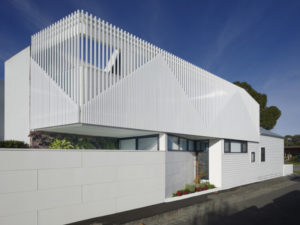Project Description
Costa Esmeralda is located thirteen kilometres north of the city of Pinamar and four hours away from Buenos Aires. Barrio Marítimo II, where the plot of land is located, is set parallel to the sea. A line of pines lies between the neighbourhood and the sea coast, in accordance with the 200-metre inset required by provincial regulations.
Rows of maritime pines occupied the lot, an almost virgin sand dune. The topography of the terrain has a two-metre slope on each side and it descends longitudinally in a gentle slant toward the sea.
There were two reasons for choosing the materials. Firstly, having built other houses in exposed concrete, we knew that this material stays in a good condition for a long time with practically no maintenance. Secondly, we thought its colour and texture would establish a harmonious dialogue with the natural surroundings.
The extensive and bright social area, closely connected to the outside, constitutes the most important partof the house. The private area comprises four bedrooms, as independent of each other as possible, each with its own bathroom. We aimed at to develop most of the building on a single level and to have a larger outdoor area on a higher level, with the presence of water and for contemplating the striking natural environment. We agreed that the trees and the particular topography of the terrain were jewels that the architectural project should respect.
We wanted the house to lie amid the woods, surrounded by the atmosphere of the location. That is why we decided to set the house back into the lot more than the minimum distances required by regulations. While recessing the house from the street would ensure more privacy in the interior, the rear part of the house would not be compromised, due to the fact that it expands visually beyond the limits of the terrain and merges into the pine woods next to the sea.
In order to produce a degree of contrast for the senses, to enter the house one must go from a gloomy semi-covered space, through a narrow staircase enclosed by exposed concrete walls and, finally, into an open and bright area: the main floor.
The main floor is designed to give every room as much privacy as possible, with each positioned in a corner of the quadrangular floor plan. The central hall houses social activities. A stairway leading up to the rooftop is situated at the heart of the floor plan and helps to structure the space, as it separates the kitchen and dining area on one side from the living room on the other. The bedroom and bathroom amenities are detached from the supporting walls.On the highest side in terms of the topography, where the platform of the main floor stands on natural ground, the side wall was reduced to a suspended partition, opening the interior to the outside through a longitudinal opening that shields the inner space from views in. On the lowest side, where the house is suspended two metres above the natural terrain, the outline is formed by a low wall with a high longitudinal opening. Both solutions allow for external views and spaces full of natural light, without losing privacy in the interior.
The sides are enclosed by blind walls with horizontal slits, while the front and the rear are enclosed by a transparent layer across the whole width and height of the box, which directs and frames views. The framed openings to the rear extend the interior towards the semi-covered deck, merging it with the outdoor space.
The malleability of concrete allowed the stairs to be conceived as an autonomous sculptural element. The walls that separate the bedrooms from the central area were treated with the same expressive plasticity, generating niches and protruding volumes that function as furniture.With regard to lighting in relation to the depth of the floor plan, it was decided that natural lighting would be enhanced from the roof. The crystal box containing the stairs bathes the centre of the social area in sunlight. Linear slits were incorporated into the inner partitions that divide off the kitchen-dining area, in order to produce different natural light effects on their surfaces throughout the day. The bathrooms are illuminated by skylights above the showers.
The supporting structure is composed of a big slab held by an inverted beams system, supported bypartitions within the floor plan and metal columns on the sides as parts of the aluminium frames. In order to emphasize the horizontality of the house and to reduce the visual impact of the structural system with beams, it was set back from the outer edges of the site, generating cantilevers that act as sun shades. A peaceful and contemplative space unfolds on the rooftop, embraced by the canopy of pines. Due to the transparency of the box containing the stairs, it affords views in all directions. This viewing space on the rooftop, with a wooden deck, a shower area and two adjacent swimming pools, is enhanced by the view of the sea.
We built a box in the midst of a slice of nature and we made it a constituent part of the environment by letting the outdoors flow into, out of and through it. The box and its surroundings therefore merge harmoniously. Through its spatial synthesis and the simple character of its materiality, our intention was to awaken its residents’ perceptions and enhance their senses, with the mystic reciprocity that often emerges between people and objects.


























































